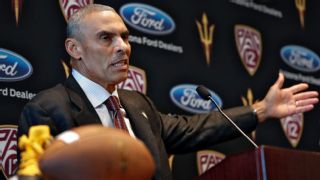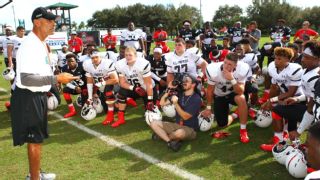|
Early in Herm Edwards' introductory news conference at Arizona State on Monday, a reporter identified himself as being from a local outlet called Devils Digest. Edwards was quick to jump in to try to learn more. "Devils Digest, huh?" Edwards said. "Where are you from, my man?" "Right here in Tempe."  "Devils Digest? OK," Edwards, with several pitchfork logos on the wall behind him, went on. "I'm Catholic now, I'm a Christian. Watch out for those Devils. I'm just saying. We're good, brother. We're good. I know. I ain't taking it personal." It's hard to allow for the possibility that Edwards didn't actually know ASU's mascot is the Sun Devils, but those who came away thinking otherwise had good reason. And with that, the first viral clip from the Great Herm Edwards Experiment was born, and the era was off and running. The man famous for "Hello?!" was reintroduced to the college football world. Edwards' appointment by his longtime friend and former agent, ASU vice president for athletics Ray Anderson, is without question the most outside-the-box hire in the coaching cycle thus far -- and maybe of the past several. He hasn't coached in nearly a decade, instead working as an NFL analyst at ESPN, hasn't coached college football in nearly three decades and is expected to retain most of the staff from a moderately successful coach, Todd Graham, who was paid approximately $12 million to go away. Whether it was the right move, and the type of success that should be expected, can be debated at length, but there's one thing for certain: Arizona State just got more interesting. To really understand why Anderson's handling of this coaching transition seems so bizarre, it's important to have some context. In the summer of 2016, Anderson was interviewed on a local sports radio talk show and made it clear he was tired of Graham's penchant for talking a big game. Going into the previous season, Graham told anyone who would listen that ASU should be considered a national title contender, only to have the team finish 6-7. To that point, Graham was 34-19 at ASU and had coached the team to its first back-to-back 10-win seasons in 39 years. "One of the things, very frankly, that we're trying to do better around here is to talk less and deliver more," Anderson said at the time. "We'll be minimum on the bravado and all the predictions about greatness and just let our play speak for us. I think you'll see that from us." Until, of course, he didn't take his own advice when he fired Graham on Nov. 26, and laid out a set of expectations for the next coach that would be on par with only the blue bloods of college football. "We should be in the top-three in the Pac-12, in my opinion, every season," he said. "There is no reason we shouldn't be top-15 every year nationally, if we do what we're supposed to do." No one should fault Anderson for trying to raise the bar, but Arizona State has not played in a major bowl since the Rose Bowl in 1997 and owns just two outright conference titles since joining the conference in 1978. In that span, ASU has finished in the top-15 just five times. Anderson became an easy target for people with more tempered expectations. "They are misguided, they are living in the past," he said. "They don't realize what we have here, and more important, they don't grasp the vision that I and [ASU president Dr. Michael Crow] have. I think they underestimate our potential and they're living in the past, and we're about the future." History indicates that the kind of success Anderson is looking will be tough to come by in Tempe, but that kind of reversal of fortune is not without recent precedent within the conference. Before Mike Bellotti hired Chip Kelly as his offensive coordinator at Oregon in 2007, the Ducks had only finished in the top-15 on five total occasions. After he arrived, they finished no lower than No. 11 in seven of the next eight years. Jim Harbaugh's arrival at Stanford, also in 2007, had the same effect for a program that finished in the top-15 just once in the Pac-10 era. In the last seven years, Stanford has finished outside of the top-12 just once. "If there's one thing I know as an attorney, I like data," Anderson said. "I like information because I don't know it all, but there are folks out there who have a really good grasp of the market and who is good and maybe who's not and who you should look and who you should stay the hell away from." And with that as a backdrop, Anderson seemingly bypassed the search process altogether in favor of hiring a friend. Everything about how the last week played out indicates Anderson had Edwards in mind from the start - and perhaps long before Graham was let go. His name surfaced as the likely target nearly immediately after Graham was fired and it doesn't appear any other candidates were seriously considered. If Edwards had already signed off on retaining coordinators Billy Napier and Phil Bennett, it helps explain why Anderson felt comfortable saying publically that any candidate that didn't see the value in retaining the coordinators "is not the guy for us."  How many serious candidates would be interested in a job where they didn't feel they had full autonomy to pick their own staff? Following the Pac-12 title game on Friday, USC athletic director Lynn Swann was asked about potential changes to Clay Helton's staff and made it clear he didn't feel that was the athletic director's role. "I don't hire assistant coaches. I think it's wrong," Swann said. "If I were to pick a head coach I would not tell the head coach he would have to have the person I want to have as offensive coordinator. He's got to build his team. I have never seen that successful." Anderson's decision could be a stroke of brilliance or it could set the program back years. That's what makes it so fascinating. Edwards instantly becomes one of the most charismatic figures in the sport and has the type of personality that could do wonder on the recruiting trail. His extensive background in football certainly qualifies him for the job, but coaches around the league don't seem too concerned. "I think everyone in the conference is bracing for UCLA to be dangerous with Chip [Kelly] there," said one Pac-12 assistant coach. "Herm Edwards? I don't think anyone is really losing sleep over that hire." ASU made a big deal about how Edwards' arrival isn't just a coaching change, but a top-down pivot from the standard way of operating toward the organizational structure more similar to what is used in professional sports. Anderson said Edwards will serve in CEO-type role in this new model, which the school described as something that will "allow the department to form a multi-layered method to the talent evaluation and recruiting processes, increase its emphasis on both student-athlete and coach development and retention, and provide a boost in resource allocation and generation." What that means, exactly, for the day-to-day operations of the program remains unclear. For now, it feels like a fancy attempt to say they're going with a new strategy while playing to win the game.
|

